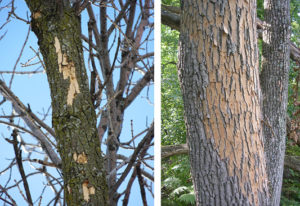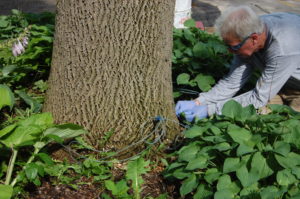By Bill McNee, forest health specialist, Oshkosh, bill.mcnee@wisconsin.gov, 920-360-0942
The cold winter months are a great time to think about emerald ash borer and whether ash trees in your yard are suitable for treatment. The pest is currently the most damaging threat to trees in Wisconsin, killing more than 99 percent of the ash trees it infests.

Woodpecker flecking is an early sign of EAB infestation when it appears in the tops of trees (left). As the infestation progresses, flecking continues down the trunk and into lower parts of the crown (right).
Woodpecker damage during the winter is often the first sign that an ash tree is infested, so it is helpful to examine your trees during this time. If you’ve determined your trees are worth treating, you can start planning now for spring when treatments are typically done. Treatments on already-infested ash trees are more likely to be successful if the trees still have low or moderate levels of woodpecker damage.
Emerald ash borer has become so widespread that homeowners should consider the treatments wherever they are in Wisconsin. The highest risk of infestation is in a quarantined county or within 15 miles of a known infestation. Elsewhere, the risk of trees becoming infested is lower, although it is suspected that there are additional, undetected EAB infestations. A map of known EAB infestations can be found at the Wisconsin EAB website.
Location isn’t the only consideration when deciding to treat. For example, the treatments are not economically practical for woodlot ash trees and need to be repeated every 1-3 years for the rest of a tree’s life (frequency of treatments will depend on the product and method used). Although there is a cost associated with treating, homeowners should compare this cost with the benefits provided by healthy trees, including increased property values, shade, lower cooling costs, aesthetics, and slowed stormwater runoff.
What you should do
Stay informed and be on the lookout for EAB. Know where the pest has been found and look for signs and symptoms of infestation. By identifying early signs of infestation, homeowners can take action before trees become hazardous or too heavily infested for insecticide treatments to be successful.
If emerald ash borer has been found in your local area or you see any of the signs or symptoms of an infestation in your ash trees, look for information online or seek advice from a tree care professional. You can search for a certified arborist at the Wisconsin Arborist Association’s website. Other businesses also conduct EAB treatments.

Preventive EAB treatments are often administered using trunk injections.
Some of the insecticide products can be applied by a homeowner and others must be applied by a certified professional. Review the available options before selecting an insecticide and treatment method. Insecticide information can be found on the national EAB Information Network website. Always follow label instructions carefully and check the credentials of any business you hire to treat your ash trees.
Note that only ash trees need to be protected against EAB. Mountain ash and prickly ash do not need protection because they are not attacked by the insect.
The decision not to treat ash trees comes with associated costs and should be weighed against the expense of a treatment. Ash trees that are left untreated are very likely to become infested and die from EAB, requiring tree removal. It may be cheaper and safer to remove these trees and replant with a different species. Homeowners should decide early whether to treat or remove so they can avoid the higher costs and safety risks as the EAB infestation progresses.
